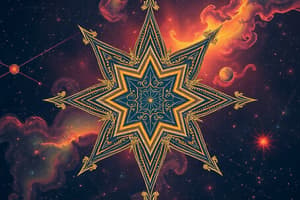Podcast
Questions and Answers
Dwarf stars are small stars with high brightness.
Dwarf stars are small stars with high brightness.
False (B)
A giant star is smaller and less bright than a dwarf star.
A giant star is smaller and less bright than a dwarf star.
False (B)
Supergiant stars are smaller and less luminous than giant stars.
Supergiant stars are smaller and less luminous than giant stars.
False (B)
Star color indicates its temperature, with blue stars being the coldest and red stars being the hottest.
Star color indicates its temperature, with blue stars being the coldest and red stars being the hottest.
The apparent brightness of a star depends on how far the star is from Earth.
The apparent brightness of a star depends on how far the star is from Earth.
Dwarf Stars are relatively ______, with low to moderate brightness.
Dwarf Stars are relatively ______, with low to moderate brightness.
A Giant Star has expanded and become much ______ than dwarf stars like our Sun.
A Giant Star has expanded and become much ______ than dwarf stars like our Sun.
Supergiant Stars are many times ______ and brighter than our Sun.
Supergiant Stars are many times ______ and brighter than our Sun.
Hypergiant Stars are extremely massive, much larger and brighter than even ______.
Hypergiant Stars are extremely massive, much larger and brighter than even ______.
The color of a star indicates its ______, with blue stars being the hottest and red stars being the coldest.
The color of a star indicates its ______, with blue stars being the hottest and red stars being the coldest.
Flashcards are hidden until you start studying




